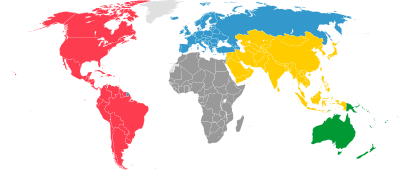Philippine Basketball Association
The Philippine Basketball Association (PBA) is a men's professional basketball league in the Philippines composed of twelve company-branded franchised teams. Founded in 1975, it is the first professional basketball league in Asia and is the second oldest continuously professional basketball league existing in the world after the NBA,[1] established before the "open era" of basketball in 1990 where FIBA allowed longstanding domestic leagues, which mostly had predated the PBA, to become professional. The league's regulations are a hybrid of rules from the NBA and FIBA.
| Current season, competition or edition: | |
 PBA logo used since 1993 | |
| Sport | Basketball |
|---|---|
| Founded | April 9, 1975 Quezon City, Philippines |
| Inaugural season | 1975 |
| Commissioner | Willie Marcial |
| Motto | Tayo ang Bida |
| No. of teams | 12 |
| Country | |
| Continent | FIBA Asia (Asia) |
| Most recent champion(s) | 2019 Philippine - San Miguel Beermen 2019 Commissioner's - San Miguel Beermen 2019 Governors' - Barangay Ginebra San Miguel |
| Most titles | San Miguel Beermen (27 titles) |
| TV partner(s) | TV5, One Sports, PBA Rush |
| Official website | www.PBA.ph |
The league played its first game at the Araneta Coliseum in Quezon City on April 9, 1975.[2] Its main offices are located along Eulogio Rodriguez Jr. Avenue (C-5 road), Eastwood City, Bagumbayan, Quezon City.
History
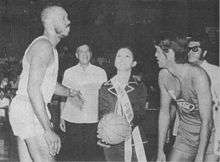
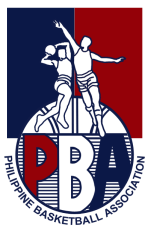
The Philippine Basketball Association was founded when nine teams left the now-defunct Manila Industrial and Commercial Athletic Association (MICAA), which was tightly controlled by the Basketball Association of the Philippines (BAP), the FIBA-recognized national association at the time.[3] With the BAP controlling the MICAA, the league was de jure amateur, as players were only paid allowances. This is much like what was done in other countries to circumvent the amateur requirement and to play in FIBA-sanctioned tournaments such as the Olympics. MICAA team owners were not pleased with how BAP, then led by Gonzalo "Lito" Puyat are taking away their players to join the national team without consulting them first.[4] On January 23, 1975, Mariwasa-Noritake Porcelainmakers' team owner, Emerson Coseteng, together with Carrier Weathermakers, Toyota Comets, Seven-Up Uncolas and Presto Ice Cream announced the formation of the PBA. The Crispa Redmanizers, Royal Tru-Orange, Tanduay Distillery, and the U/Tex Weavers later joined the upcoming professional league. Leopoldo Prieto, the coach for the Philippines at the 1956 Melbourne Olympics, was appointed as the first commissioner and Coseteng was chosen as the first president of the league's Board of Governors.[5] The first game of the league was held at the Araneta Coliseum on April 9, 1975, featuring Mariwasa-Noritake and Concepcion Carrier.
The league's first 10 years was known for the intense rivalry of the Crispa Redmanizers and the Toyota Tamaraws, still considered as one of the greatest rivalries in league history. Big names such as Robert Jaworski, Ramon Fernandez, Francis Arnaiz, Atoy Co, Bogs Adornado and Philip Cezar played for those squads before the two teams disbanded in 1983 and 1984 respectively. Following their disbandment, the league moved from the Araneta Coliseum to ULTRA in Pasig. There, the league continued to be popular, as several former Toyota and Crispa players suited up for different teams.
During the mid to late 80s, Jaworski and Ginebra San Miguel became the league's most popular squad for their "never say die" attitude.[6] The team had intense rivalries with the Tanduay Rhum Masters, which was led by Jaworski's ex-Toyota teammate-turned-rival Fernandez, and later the expansion Purefoods Corporation and younger players Alvin Patrimonio, Jerry Codiñera, Jojo Lastimosa and Fernandez (who moved from Tanduay).
By the end of the 1980s, San Miguel Beer won numerous championships that included the 1989 Grand Slam, led by coach Norman Black and former national team stars Samboy Lim and Hector Calma.
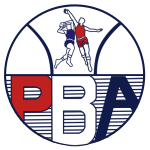
In 1989, FIBA voted to allow professionals to play in their sanctioned tournaments, hence the PBA's players are now able to represent the country internationally. In 1990, the league sent its first all-professional squad to the Asian Games, earning a silver medal. The PBA would later send three more all-pro squads to the event.
The early 1990s saw Ginebra and Shell forming an intense rivalry that included Ginebra's walkout in 1990 finals against Shell and the team's dramatic comeback from a 3-1 deficit to beat Shell in the 1991 First Conference. Patrimonio, Allan Caidic, and a host of others became the league's main attraction.
By 1993, the league moved to the Cuneta Astrodome in Pasay and later saw the Alaska Milkmen win the 1996 grand slam and nine titles in the decade.Coinciding the moved to Cuneta Astrodome, the PBA unveiled the new logo, which was the winning design in the nationwide logo design contest, which attracted more than 2,000 entries. The designer of the winning logo is Oscar de Castro (www.oscardecastro.ca) a professional graphic designer from Manila who is now based in Winnipeg, Manitoba, Canada.
From 1999-2000, the PBA endured controversy. Several expatriate cagers arrived on the scene (such as Asi Taulava, Danny Seigle and Eric Menk). Their lineage was questionable and most of them were deported for falsifying documents. The arrival of dozens of these players was a counter to the fledgling Metropolitan Basketball Association, a regional-based professional league formed in 1998. After ABS-CBN's 2001 abandonment, the MBA faced mounting expenses and would fold within a year. Despite the MBA's disbandment and the arrival of those players to the PBA, attendance went sour for the PBA in 2002 and was even worse the following year.
In 2004, the league introduced drastic scheduling changes, when it decided to begin the season in October instead of January. The change in starting the season allowed the league to accommodate international tournaments held from June to September and it fit better with college hoops, the NCAA and the UAAP, whose seasons run from June to October. The league also reduced the number of conferences from three to two, renaming the All-Filipino Cup as the Philippine Cup and introducing a new import laden tournament named as the Fiesta Conference. To accommodate these changes, a transitional tournament, the 2004 PBA Fiesta Conference was held from February to July, which was won by the Barangay Ginebra Kings. The league also began to hold the annual All-Star weekend in the provinces, alternating from Luzon and Visayas/Mindanao provinces every year.
The league regained some popularity by this year, thanks in large part to Barangay Ginebra's three PBA championships led by Eric Menk, Jayjay Helterbrand and Mark Caguioa. Solid marketing and arrival of collegiate stars from the UAAP and the NCAA also worked in the PBA's favor.
By 2005, the league would take on the role of Philippine national representation under Chot Reyes, when FIBA lifted the suspension of the country following the formation of the Samahang Basketbol ng Pilipinas despite a ninth-place finish in the 2007 FIBA Asia Championship. In 2009, however, the all-amateur Smart Gilas team became the country's official representative in international competitions. The PBA's role in forming a national team was thus reduced to sending up reinforcements to beef up the national squad.
After the appointment of Chito Salud, son of former commissioner Rudy Salud as the commissioner of the PBA, the league returned the three-conference format starting in the 2010-11 season. This also ushered the return of the previously retired conferences, the Commissioner's and Governors' cups.
The beginning of 2010's also saw the dominance of the Talk 'N Text Tropang Texters, who nearly got the Grand Slam in the 2010–11 season and won the Philippine Cup in three consecutive years (2010–11, 2011–12, 2012–13) enabling them to permanently keep possession of the Jun Bernardino Trophy, the trophy given to the Philippine Cup champions.
On May 19, 2013, the third game of the PBA Commissioner's Cup Finals between the Alaska Aces and the Barangay Ginebra San Miguel set the all-time basketball attendance record of 23,436 at the Smart Araneta Coliseum,[7] which broke the previous record of 23,108 set 11 days earlier that featured the semifinals series doubleheader between Alaska vs. San Mig Coffee and Barangay Ginebra vs. Talk 'N Text.[8] This record was eventually broken on February 12, 2014, when the seventh game of the 2013-14 PBA Philippine Cup Semifinals series between Barangay Ginebra San Miguel and San Mig Super Coffee Mixers set the all-time basketball attendance record of 24,883.[9]
The 2013–14 season became historic as the San Mig Super Coffee Mixers became the fourth team to win the Grand Slam. Tim Cone, the coach of the Coffee Mixers also made history when he became the first coach to win two Grand Slams.
For the 2014–15 season, the league expanded to twelve teams, after accepting two new franchises: Kia Sorento and Blackwater Elite. The league held its opening ceremonies at the Philippine Arena and set an all-time Philippine basketball attendance record of 52,612.[10]
On February 15, 2015, in the middle of the 2014–15 PBA season, commissioner Chito Salud announced that he will step down as the league's commissioner and was succeeded by Chito Narvasa starting the 2015–16 PBA season. Salud was then appointed as the President and CEO of the league, when the board of governors decided to restructure the league and create the President/CEO position to manage the league's marketing, expansion and business-related matters. The Commissioner (who will also be the league's Chief Operating Officer) will handle game-related matters.
Salud, however, also stepped down as the league's President and CEO on December 31, 2015 and was replaced by incumbent PBA chairman Robert Non. The board of governors later appointed Chito Narvasa as the President and CEO. The said position was eventually dissolved before the start of the 2016 Governors' Cup.
Amid controversies during his term, Narvasa stepped down on December 31, 2017. The board appointed Media Bureau chief Willie Marcial as his replacement on January 25, 2018.
Competition format
Conferences
Unlike other leagues, there is no "season champion" of the PBA. Instead, the season is divided into conferences or tournaments (not to be confused with the definition of a "conference" in a sporting context as a grouping of teams based on geography or historical affiliation), wherein the teams compete for a conference cup. The winners of the conference cups do not face each other at the end of the season to determine the season champion; instead all conference champions are league champions, with the Philippine Cup being the most prestigious conference of the season.[11]
A season is usually composed of three conferences. Since the 2010–11 season, the conferences were named Philippine, Commissioner's and Governors' Cups, usually ending in a best-of-seven series where the winner took the conference cup.[12] If the same team won all of the conferences, the team was said to be the "Grand Slam" champion. A draft is held after the season-ending Governors' Cup. An opening ceremony is held before the start of the first game of the season. The conference format is similar to Apertura and Clausura in Latin American football.
Game rules
The PBA has a hybrid of FIBA and NBA rules:[13]
- A game consists of four 12-minute quarters, the NBA standard.
- The three-point line's distance is set back to 6.75 m (22.1 feet), which is the FIBA's three-point distance for international competitions.
- Zone defenses are allowed.
- A team enters the penalty situation after the fifth foul in a quarter, with each successive foul entitling the fouled player to two free-throw attempts. In the last two minutes of regulation, teams are only allowed one foul to give, as in NBA rules. Overtime periods allow each team two fouls in the first three minutes and one foul in the last two minutes, as in NBA rules.
- Newcomers enter the league via a draft and required to play in the D-League for a certain number of tournaments before being eligible to be drafted.
- Non-Filipinos can play as "imports" and only in certain conferences, the Commissioner's Cup and the Governors' Cup. The Commissioner's Cup allows teams to hire imports no taller than 6'10". In the Governors' Cup, imports within the height limit of 6'5" are allowed to play.
- The league implements the Trent Tucker Rule.
- An advantage foul, similar to the "unsportsmanlike foul" of FIBA rules, is called when the offensive player is fouled by an opposing player while in a fastbreak situation without going for the ball. The offense is given two free throws and regains the ball.
Eligibility
Player eligibility
Natural-born Filipino citizens are generally eligible to become part of a PBA team through the PBA draft. Foreigners as well as naturalized Filipino citizens with no Filipino parents can not join the league through the PBA draft; both who could only play as imports.[14]
Coach eligibility
Head coaching role for teams in the PBA is generally only available to Filipino citizens since foreigners who are classified as non-resident aliens are bared from serving the role as head coach. It is possible for a foreigner to be a head coach of a PBA team by acquiring permanent residency such as in the case of Tim Cone and Norman Black who married Filipinos and being a holder of a Special Resident Retiree's Visa (SRRV) such as in the case of Rajko Toroman who became eligible for an SRRV after residing in the country for at least five years. The restriction on foreigners has been in place since 1991.[15]
Teams
All franchises are owned by corporations since the league's inception in 1975, being the successor of the Manila Industrial and Commercial Athletic Association, an amateur league which also featured corporate teams.[16] They are not based on geographic locale, so they do not play in a home arena. The names of the teams often changes, often depending on what product or service the owners, like to advertise. A name change could be drastic, to the point of switching industries entirely, such as in the case of the Pepsi Mega Bottlers which changed their names to the Mobiline Cellulars (now TNT KaTropa).[16]
A team's name is often divided into two parts; the first is the company or brand name, then the product or a moniker - usually connected to the business of the company. In some cases, the brand name and the moniker can be fused. For example, the San Miguel Beermen is a team owned by the San Miguel Brewery of the San Miguel Corporation, makers of the popular San Miguel Beer brand.
Current teams
| Philippine Basketball Association current teams | ||||||
|---|---|---|---|---|---|---|
| Team | Company | Colors | Joined PBA | Titles | Head coach | |
| Alaska Aces | Alaska Milk Corporation | 1986 | 14 | Jeffrey Cariaso | ||
| Barangay Ginebra San Miguel | Ginebra San Miguel, Inc.♯ | 1979 | 12 | Tim Cone | ||
| Blackwater Elite | Ever Bilena Cosmetics, Inc. | 2014 | 0 | Nash Racela | ||
| Magnolia Hotshots | San Miguel Food and Beverage♯ | 1988 | 14 | Chito Victolero | ||
| Meralco Bolts | Manila Electric Company° | 2010 | 0 | Norman Black | ||
| NLEX Road Warriors | Manila North Tollways Corporation° | 2014 | 0 | Yeng Guiao | ||
| NorthPort Batang Pier | Sultan 900 Capital, Inc. | 2012 | 0 | Pido Jarencio | ||
| Phoenix Super LPG Fuel Masters | Phoenix Petroleum Philippines, Inc. | 2016 | 0 | Louie Alas | ||
| Rain or Shine Elasto Painters | Asian Coatings Philippines, Inc. | 2006 | 2 | Caloy Garcia | ||
| San Miguel Beermen | San Miguel Brewery, Inc.♯ | 1975[lower-alpha 1] | 27 | Leo Austria | ||
| Terra Firma Dyip | Terra Firma Realty Development Corporation | TBA | 2014 | 0 | Johnedel Cardel | |
| TNT KaTropa | Smart Communications° | 1990 | 7 | Bong Ravena | ||
Notes
- The San Miguel Beermen took a leave of absence from the first two conferences of the 1986 season.
- (♯) - Denotes a San Miguel Corporation subsidiary.
- (°) - Denotes an MVP group subsidiary.
Team popularity
In 2008, a survey by the Social Weather Stations showed that Purefoods shares the honor of the league's most popular team along with Barangay Ginebra.[17][18][19] It appeared that Ginebra was the most popular team among men, while Purefoods was the most popular among women.[20] Also, Ginebra was more popular in Metro Manila and Luzon and in classes ABC, while Purefoods was more popular in Visayas and Mindanao and in class D. The two teams were tied for most supporters in class E.[21] In terms of percentage of supporters, the survey showed that, after Ginebra and Purefoods (which both got 31%),[22] are Magnolia (21%), Alaska (13%), Sta. Lucia (5%), Red Bull (4%), Talk N' Text (3%), Coca-Cola (1%), and Air 21 (1%).[23]
Notably, the top three teams that have the most supporters have also been considered as the most talent-laden teams. They also fall under the San Miguel Corporation umbrella. With these three teams acquiring players through allegedly lopsided trades and performing strong in the past several seasons, the PBA has been considered by some as an "SMC league".[24]
Defunct and guest teams
The most prominent defunct teams were the Crispa Redmanizers and the Toyota Super Corollas.
Among guest teams, most notable was the American Nicholas Stoodley team that won the 1980 Invitational Conference.
Administration
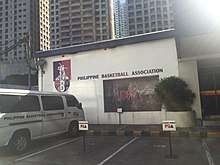
The league is currently headed by a Commissioner, and the Chairman of the PBA Board of Governors. The Commissioner handles the marketing and administration aspects as well as the technical, game related concerns of the PBA and its developmental league. The Chairman of the PBA Board of Governors is elected, together with the Vice Chairman and Board Treasurer before the start of the season among each of the league's representatives to the board.
By tradition, the incumbent Vice Chairman and Treasurer will assume the Chairmanship and the Vice-Chairmanship respectively the following season.
Commissioners
| Commissioner | Term | ||
|---|---|---|---|
| From | Until | ||
| 1 | Leo Prieto | April 9, 1975 | December 1983 |
| 2 | Mariano Yenko | January 1984 | December 1987 |
| 3 | Rodrigo Salud | January 28, 1988 | January 10, 1992[25] |
| 4 | Rey Marquez | January 10, 1992[25] | December 23, 1993[26] |
| 5 | Jun Bernardino | January 14, 1994[26] | December 31, 2002[27] |
| 6 | Noli Eala | January 1, 2003[27] | August 7, 2007 |
| Sonny Barrios was officer-in-charge or acting commissioner from August 2007–January 2008 | |||
| 7 | Sonny Barrios[28][29] | January 24, 2008 | August 26, 2010 |
| 8 | Chito Salud | August 26, 2010 | July 31, 2015 |
| 9 | Chito Narvasa | August 1, 2015[30] | December 31, 2017 |
| Willie Marcial was officer-in-charge or acting commissioner from January 1–25, 2018 | |||
| 10 | Willie Marcial | January 25, 2018[31] | Present |
Board of Governors Presidents and Chairmen
| Board of Governors President (1975–1986) | ||
|---|---|---|
| Season/s | President | Team |
| 1975 | Emerson Coseteng | Mariwasa-Norikate Porcelainmakers |
| 1976–1982 | Domingo Itchon | Tanduay Rhum Esquires |
| 1983–1986 | Carlos Palanca III | Ginebra San Miguel |
| Board of Governors Chairman (1987–present) | ||
| 1987–1990 | Rey Marquez | Formula Shell Spark Aiders |
| 1991–1993 | Luis "Moro" Lorenzo, Sr. | Pepsi Hotshots |
| 1994 | Wilfred Steven Uytengsu | Alaska Milkmen |
| 1995 | Jose Concepcion III | Sunkist Orange Juicers |
| 1996 | Teodoro Dimayuga | Purefoods TJ Hotdogs |
| 1997 | Nazario Avendaño | San Miguel Beermen |
| 1998 | Bernabe Navarro | Ginebra San Miguel |
| 1999 | Reynaldo Gamboa | Formula Shell Zoom Masters |
| 2000 | Wilfred Steven Uytengsu | Alaska Milkmen |
| 2001 | Ignatius Yengco | Talk 'N Text Phone Pals |
| 2002 | Francisco Alejo III | (Purefoods TJ Hotdogs |
| 2003 | Casiano Cabalan, Jr. | Barangay Ginebra Kings |
| 2004–05 | Manuel Encarnado | Sta. Lucia Realtors |
| 2005–06 | Eliezer Capacio | San Miguel Beermen |
| 2006–07 | Victorico Vargas | Talk 'N Text Phone Pals |
| 2007–08 | Tony Chua | Red Bull Barako |
| 2008–09 | Joaqui Trillo | Alaska Aces |
| 2009–10 | Alberto Alvarez | Air21 Express |
| 2010–11 | Rene Pardo | B-Meg Llamados |
| 2011–12 | Mamerto Mondragon | Rain or Shine Elasto Painters |
| 2012–13 | Robert Non | Barangay Ginebra San Miguel |
| 2013–14 | Ramon Segismundo | Meralco Bolts |
| 2014–15 | Patrick Gregorio | Talk 'N Text Tropang Texters |
| 2015–16 | Robert Non | San Miguel Beermen |
| 2016–17 | Mikee Romero | GlobalPort Batang Pier |
| 2017–present | Victorico Vargas | TNT KaTropa |
PBA records and clubs
There are all-time records written in Philippine Basketball Association records, as well as distinctions like the PBA career scoring leaders, PBA 2,000 Assists Club, PBA 500 Three-Point Club, PBA 600 Most Game Club, and PBA Top 40 Rebounder.
Rivalries
The most famous matchup was the Crispa-Toyota rivalry of the 1970s. Fans faithfully supported their favorite squads and appeared in the multitudes at the Araneta Coliseum, or wherever the archrivals had met. In those days, the players were very passionate. On one occasion, they engaged in a major brawl, leading to the arrest and detention of several players from both clubs at Fort Bonifacio.[32]
The most heated rivalry in the PBA today is that of two teams representing the Ginebra franchise and the Purefoods franchise. The rivalry is now commonly known as the Manila Clasico. It traces its roots on the original Añejo–Purefoods rivalry of the late 1980s to early 1990s.[33]
Other short-lived or less intense rivalries include:
- Tanduay vs Ginebra (1986–1987 rivalry)
- Ginebra–Shell rivalry (1990s rivalry)
- Purefoods–Swift rivalry (1990s corporate rivalry)
- Añejo/Ginebra vs San Miguel (late-1980s to present rivalry)
- Ginebra/Gordon's Gin vs Alaska (late-1980s to present rivalry)
- Red Bull vs. the San Miguel franchises (Barangay Ginebra, San Miguel and Purefoods, 2000–2007)
- Talk 'N Text vs. San Miguel/Petron (2010–2011)
- Purefoods/San Mig Coffee/B-Meg vs. Rain or Shine (2009–present, "New Age Rivalry or Kontrapelo")[34]
Media coverage
The PBA has been covered by television and other media since its opening day. Their current TV and radio partner is One Sports. Games are being aired on television via 5 and PBA Rush with the latter aired in high definition. Radio broadcast is being aired on Radyo5 92.3 News FM. The PBA can also be watched worldwide on Kapatid International and YouTube (in selected countries)
- PBA on KBS (1975, 1977)
- PBA on BBC (1976)
- PBA on GTV (1978–1981)
- GTV was renamed into MBS in 1980, henceafter the broadcast became known as the PBA on MBS
- PBA on Vintage Sports (1982–1999)
- PBA on Viva TV (2000–2002)
- Aired on IBC from 2000 to 2002
- PBA on NBN and IBC (2003)
- Parallel broadcasts on NBN and IBC; later IBC simulcasts of the NBN broadcasts. IBC stopped airing the games on October 2003.
- PBA on ABC (2004–2008)
- Became known as the PBA on TV5 after ABC reformatted on August 2008.
- PBA on Solar Sports (2008–2011)
- Aired on Solar TV from October 2008 to February 2011. Also became known as the "PBA on C/S9" before CS/9 re-formatted on November 29, 2009 to Solar TV.
- Aired on Studio 23 from February 2011 to August 2011.
- Replays also air on Basketball TV.
- PBA on One Sports (2011–present)
- Aired on IBC from October 2011 to May 2013 under the AKTV on IBC block. The last AKTV programming block aired until May 31, 2013 due to expiration of the blocktime agreement contract between MediaQuest Holdings and IBC.
- Aired on TV5 starting with the 2013 PBA Commissioner's Cup Finals. It was moved to IBC under the Sports5 production on August 14, 2013 to September 2013. Airs on primetime (Wednesdays, Fridays and Sundays) and late afternoon (Saturdays) starting from the 2016 Governors' Cup. previously aired on late afternoon (weekends) from 2013–14 season to 2016 Commissioner's Cup.
- Aired on TV5 since November 17, 2013. Simulcast with AksyonTV from November 2013 to July 2015.
- Simulcast in high definition on Cignal HD Channel 198 with no commercial breaks from May 2014 to present. Broadcast with English commentary since January 2016.
- Simulcast in high definition on Hyper with no commercial breaks from January 2016 to May 2016 in English commentary.
- Simulcast in high definition on PBA Rush from July 2016 to present in English commentary.
- Aired via live streaming on www.sports5.ph from October 2014 to present
- PBA on Fox Sports (2013–2016)
- Live simulcast of Sunday doubleheaders in English commentary.
Playing venues
.jpg)
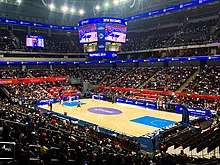
As teams do not represent geographic locales, the league itself rents venues for which it plays on. The PBA usually plays a doubleheader three times a week in Metro Manila arenas, and a game on Saturdays in the provinces, popularly known as "out-of-town" games.
A majority of elimination round games are held in the Smart Araneta Coliseum in Quezon City[35] and the Mall of Asia Arena in Pasay.[36][37] When both arenas are unavailable, the alternate venues are the Cuneta Astrodome in Pasay and the PhilSports Arena in Pasig City. Occasionally, provincial games are hosted in selected venues throughout the country. Playoff games are usually held at venues in Metro Manila, most often at the Smart Araneta Coliseum. However, recent incentives to promote the league throughout the country have resulted in out-of-town games.
See also
- The Leo
- List of sports attendance figures - the PBA in a global context
- PBA Developmental League
- PBA Rush
References
- Bartholomew, Rafe. Pacific Rims. New American Library, 2010, p. 13.
- Bartholomew 2010, p. 13.
- Revolution, evolution, and the tale of the undersized PBA forward Archived July 18, 2012, at the Wayback Machine, Jay P. Mercado, InterAKTV, April 8, 2012
- End Of An Era, Manila Bulletin, January 8, 2013
- PBA: 35 years and counting Archived August 26, 2018, at the Wayback Machine, Eddie Alinea, Sports Manila.net
- Jaworski and the birth of ‘Never Say Die’ Archived July 14, 2012, at the Wayback Machine, Jay P. Mercado, InterAKTV, March 7, 2012
- Alaska-Ginebra Game Three sets new all-time Araneta Coliseum basketball attendance record Archived January 6, 2014, at the Wayback Machine, InterAKTV, May 19, 2013
- BA sets all-time Araneta Coliseum record with San Mig Coffee-Alaska, Ginebra-Talk ‘N Text twinbill Archived January 6, 2014, at the Wayback Machine, Rey Joble, InterAKTV, May 9, 2013
- "Game Seven between Ginebra, San Mig Coffee sets all-time record attendance". InterAksyon.com. Archived from the original on February 22, 2014. Retrieved February 12, 2014..
- "52k-strong fans watch PBA opener at Philippine Arena". Interaksyon.com. Archived from the original on October 21, 2014. Retrieved October 19, 2014.
- "Mighty Talk 'N Text defeats gallant Powerade to retain Philippine Cup". InterAKTV. January 29, 2012. Archived from the original on July 18, 2012. Retrieved August 27, 2012.
- PBA plans to go back to 3-conference format, GMA News Online, July 7, 2010
- "Exec: New rules to make PBA games more exciting", GMANews.tv, retrieved September 20, 2009
- https://www.gmanetwork.com/news/sports/content/215448/barring-a-revision-in-pba-rules-douthit-can-only-play-as-an-import/story/
- Fopalan, Renee Avena (January 30, 2013). "Why Tim Cone and Norman Black can coach in the PBA and how Rajko Toroman can too". GMA News. Retrieved June 17, 2020.
- Pinsker, Joe (May 31, 2016). "The Pro Sports League With the Weirdest Team Names in the World". The Atlantic. Retrieved June 8, 2020.
- "SWS Sports Survey: Purefoods and Ginebra tie as most popular in PBA", Social Weather Stations, archived from the original on August 18, 2008, retrieved August 14, 2008
- "Kings, Giants are most popular PBA teams", The Manila Times Internet Edition, retrieved August 16, 2008
- "SWS: Purefoods, Ginebra tied as most popular teams in PBA", GMANews.tv, retrieved August 16, 2008
- "Favorite Philippine Basketball Association Teams: By Sex, April 2008", Social Weather Stations, archived from the original on April 7, 2010, retrieved August 15, 2008
- "Favorite Philippine Basketball Association Teams: By Area and Class, April 2008", Social Weather Stations, archived from the original on April 7, 2010, retrieved August 15, 2008
- "SWS: Purefoods, Ginebra tied as most popular teams in PBA", GMANews.Tv, retrieved August 15, 2008
- "Favorite Philippine Basketball Association Teams: Philippines, April 2008", Social Weather Stations, archived from the original on April 7, 2010, retrieved August 15, 2008
- "The SMC League", Fire Quinito, archived from the original on February 11, 2010, retrieved February 8, 2010
- Marquez takes over, Rocky Nazareno, Manila Standard, January 11, 1992
- Marquez retiring after 2 years in the PBA, Manila Standard, December 23, 1993
- 6th PBA head: Eala succeeds Jun B as commissioner, June Navarro, Philippine Daily Inquirer, December 12, 2002
- www.abs-cbnnews.com, Sonny Barios named new PBA commish Archived October 28, 2007, at the Wayback Machine
- www.abs-cbnnews.com,Barrios named PBA commish
- Former coach Chito Narvasa named new PBA commissioner via 12-0 vote by board Archived May 18, 2015, at the Wayback Machine, Richard Dy, spin.ph, May 14, 2015
- Erstwhile OIC Willie Marcial named PBA commissioner, given three-year term
- "PBA legends recall league's greatest moments". GMANews.TV. April 9, 2010. Retrieved February 21, 2011.
- Tordecilla, Jaemark. "Manila Clasico: Why the Ginebra-Purefoods rivalry endures". InterAKTV. Archived from the original on March 12, 2012. Retrieved March 11, 2012.
- "Llamados, Painters new age rivals in the PBA", GMANews.tv, retrieved July 19, 2010
- "Corporate - Araneta Coliseum". Araneta Coliseum. 2006. Archived from the original on March 10, 2012. Retrieved February 6, 2011.
- Big Dome still main PBA venue, but MOA Arena an alternative option | InterAKTV Archived March 6, 2014, at the Wayback Machine
- "Hataw Tabloid". Archived from the original on January 3, 2013. Retrieved December 10, 2018.
